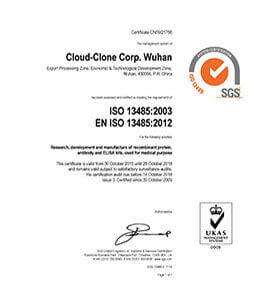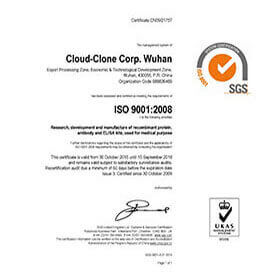Polyclonal Antibody to Cathelicidin Antimicrobial Peptide (CAMP)
CAP18; FALL39; HSD26; LL37; 18 kDa Cationic Antimicrobial Protein; Antibacterial protein FALL-39; FALL-39 peptide antibiotic
- Product No.PAC419Mu02
- Organism SpeciesMus musculus (Mouse) Same name, Different species.
- SourcePolyclonal antibody preparation
- HostRabbit
- Potencyn/a
- Ig Type IgG
- PurificationAntigen-specific affinity chromatography followed by Protein A affinity chromatography
- LabelNone
- Immunogen n/a
- Buffer FormulationPBS, pH7.4, containing 0.02% NaN3, 50% glycerol.
- TraitsLiquid
- Concentration500µg/mL
- Organism Species Moren/a
- ApplicationsWB; IHC; ICC; IP.
If the antibody is used in flow cytometry, please check FCM antibodies. - Downloadn/a
- UOM 20µl100µl 200µl 1ml 10ml
- FOB
US$ 108
US$ 252
US$ 360
US$ 900
US$ 3600
For more details, please contact local distributors!
SPECIFITY
The antibody is a rabbit polyclonal antibody raised against CAMP. It has been selected for its ability to recognize CAMP in immunohistochemical staining and western blotting.
USAGE
Western blotting: 0.2-2µg/mL;1:250-2500
Immunohistochemistry: 5-20µg/mL;1:25-100
Immunocytochemistry: 5-20µg/mL;1:25-100
Optimal working dilutions must be determined by end user.
STORAGE
Store at 4°C for frequent use. Stored at -20°C in a manual defrost freezer for two year without detectable loss of activity. Avoid repeated freeze-thaw cycles.
STABILITY
The thermal stability is described by the loss rate. The loss rate was determined by accelerated thermal degradation test, that is, incubate the protein at 37°C for 48h, and no obvious degradation and precipitation were observed. The loss rate is less than 5% within the expiration date under appropriate storage condition.
GIVEAWAYS
INCREMENT SERVICES
-
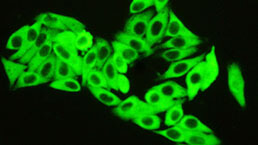 Antibody Labeling Customized Service
Antibody Labeling Customized Service
-
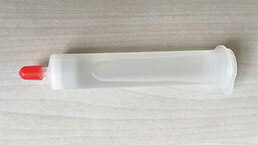 Protein A/G Purification Column
Protein A/G Purification Column
-
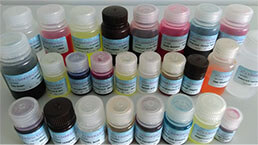 Staining Solution for Cells and Tissue
Staining Solution for Cells and Tissue
-
 Positive Control for Antibody
Positive Control for Antibody
-
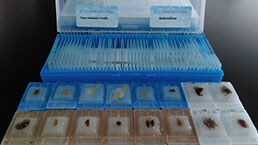 Tissue/Sections Customized Service
Tissue/Sections Customized Service
-
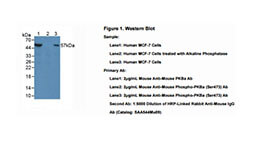 Phosphorylated Antibody Customized Service
Phosphorylated Antibody Customized Service
-
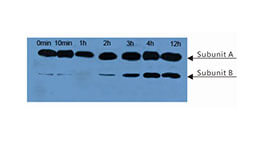 Western Blot (WB) Experiment Service
Western Blot (WB) Experiment Service
-
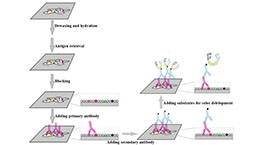 Immunohistochemistry (IHC) Experiment Service
Immunohistochemistry (IHC) Experiment Service
-
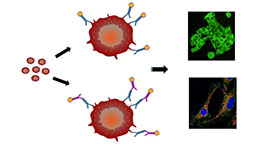 Immunocytochemistry (ICC) Experiment Service
Immunocytochemistry (ICC) Experiment Service
-
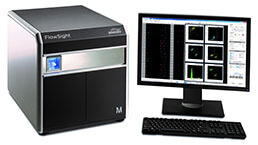 Flow Cytometry (FCM) Experiment Service
Flow Cytometry (FCM) Experiment Service
-
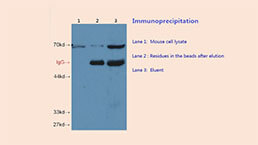 Immunoprecipitation (IP) Experiment Service
Immunoprecipitation (IP) Experiment Service
-
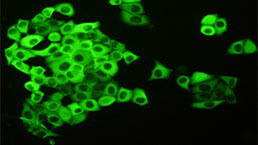 Immunofluorescence (IF) Experiment Service
Immunofluorescence (IF) Experiment Service
-
 Buffer
Buffer
-
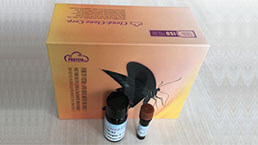 DAB Chromogen Kit
DAB Chromogen Kit
-
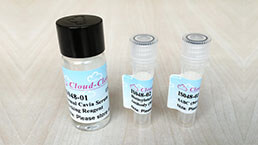 SABC Kit
SABC Kit
-
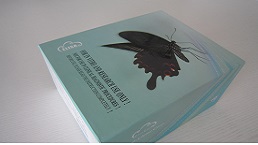 Long-arm Biotin Labeling Kit
Long-arm Biotin Labeling Kit
-
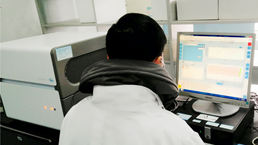 Real Time PCR Experimental Service
Real Time PCR Experimental Service
| Magazine | Citations |
| University of Waikato | The Assessment of Vitamin D, Antimicrobial Peptides and Procalcitonin in Bronchiectasis Waikato:Source |
| Clin Infect Dis. | Host immune response to tuberculous meningitis Pubmed:25301213 |
| Vaccine | On birth single dose live attenuated OPV and BCG vaccination induces gut cathelicidin LL37 responses at 6 week of age: A natural experiment Pubmed:25444792 |
| Urology | Modulating the Internalization of Bacille Calmette-Guérin by Cathelicidin in Bladder Cancer Cells Pubmed:25681250 |
| Urology | Modulating the Internalization of Bacille Calmette-Guérin by Cathelicidin in Bladder Cancer Cells PubMed: 25681250 |
| Sarcoidosis Vasc Diffuse Lung Dis | Cathelicidin as a link between sarcoidosis and tuberculosis PubMed: 26422567 |
| Allergy and Asthma Proceedings | The association of vitamin D, cathelicidin, and vitamin D binding protein with acute asthma attacks in children PubMed: 26108071 |
| J Clin Microbiol. | Swiftly Decreasing Cerebrospinal Fluid Cathelicidin Concentration Predicts Improved Outcome in Childhood Bacterial Meningitis. Pubmed:27008883 |
| experimental dermatology | Light-emitting diodes downregulate cathelicidin, kallikrein and toll-like receptor 2 expressions in keratinocytes and rosacea-like mouse skin. pubmed:27315464 |
| PLOS ONE | Reduced Expression of the Extracellular Calcium-Sensing Receptor (CaSR) Is Associated withActivation of the Renin-Angiotensin System (RAS) to Promote Vascular Remodeling in the Pathogenesis of Essential Hypertension. pubmed:27391973 |
| Front Pharmacol. | Ginsenoside Rg5 Inhibits Succinate-Associated Lipolysis in Adipose Tissue and Prevents Muscle Insulin Resistance. pubmed:28261091 |
| Allergologia et immunopathologia | The relation of innate and adaptive immunity with viral-induced acute asthma attacks: Focusing on IP-10 and cathelicidin pubmed:27955890 |
| Chinese Journal of Osteoporosis and Bone Mineral Research | Effects of cold exposure on the bone marrow adipose tissue DOI: 10.3969/j.issn.1674-2591.2017.05.008 |
| Scientific Reports | Measurements of AMPs in stratum corneum of atopic dermatitis and healthy skin–tape stripping technique Pubmed:29374283 |
| Experimental Parasitology | Antimalarial activity of vitamin D3 (VD3) does not result from VD3-induced antimicrobial agents including nitric oxide or cathelicidin Pubmed: 30904694 |
| Theranostics | Myeloid cell-derived LL-37 promotes lung cancer growth by activating Wnt/β-catenin signaling Pubmed: 31149039 |
| INTERNATIONAL JOURNAL OF MOLECULAR SCIENCES | Short-Term versus Long-Term Culture of A549 Cells for Evaluating the Effects of Lipopolysaccharide on Oxidative Stress, Surfactant Proteins and Cathelicidin LL-37 Pubmed: 32050475 |
| MICROB PATHOGENESIS | Hypovitaminosis D and reduced cathelicidin are strongly correlated during the multidrug therapy against leprosy Pubmed: 32645421 |
| International Journal of Nanomedicine | Effect of Lonicerae japonicae Flos Carbonisata-Derived Carbon Dots on Rat Models of Fever and Hypothermia Induced by Lipopolysaccharide Pubmed: 32606669 |
| 博士论文 | Relações causais entre a expressão dos genes do receptor de Vitamina D e do Peptídeo Antimicrobiano Catelicidina sobre marcadores sorológicos de pessoas com … |
| PLoS One | Beneficial impact of cathelicidin on hypersensitivity pneumonitis treatment¡ªIn vivo studies 33999928 |
| New Med | Analysis of the level of non-specific and specific immunity parameters in saliva of children with osteogenesis imperfecta and study of relationships between?¡ |
| Type I interferons link skin-associated dysbiotic commensal bacteria to pathogenic inflammation and angiogenesis in rosacea | |
| Int J Mol Sci | Compartmentalized Innate Immune Response of Human Fetal Membranes against Escherichia coli Choriodecidual Infection Pubmed:35328414 |
| Cell Rep | LL-37 transports immunoreactive cGAMP to activate STING signaling and enhance interferon-mediated host antiviral immunity Pubmed:35649354 |



